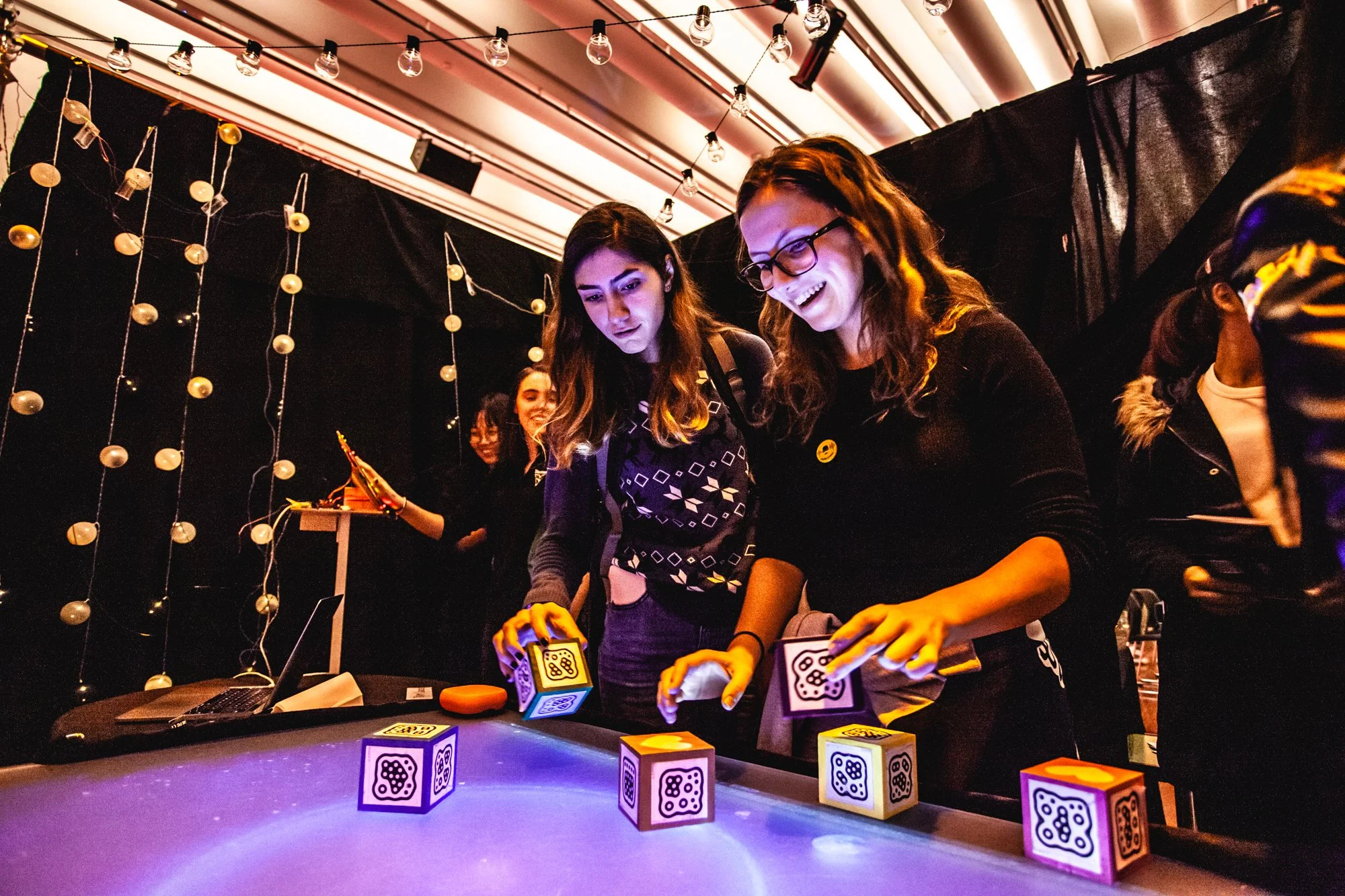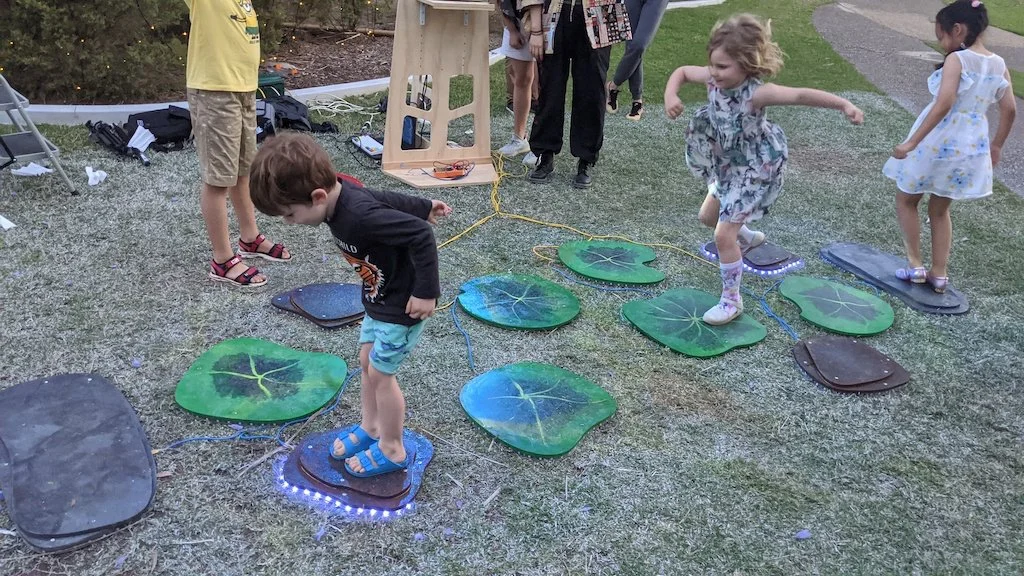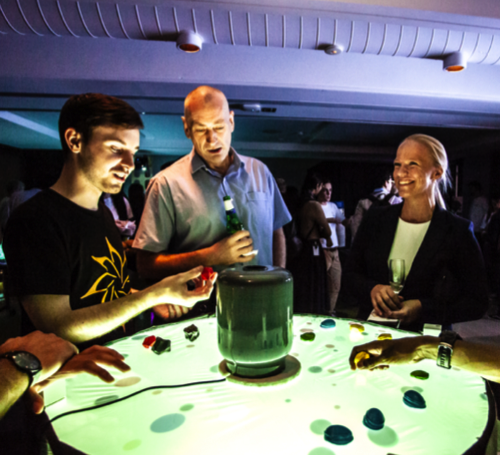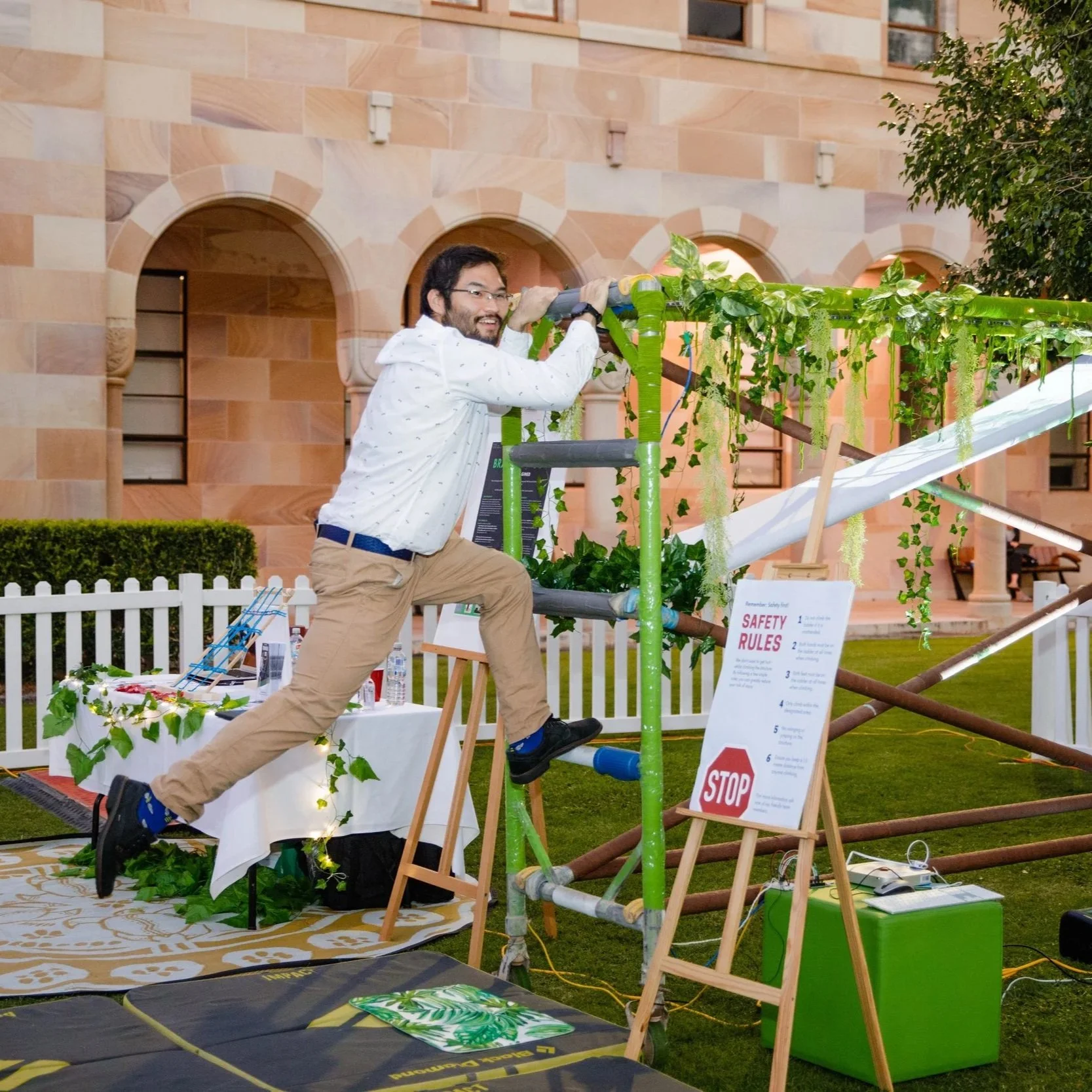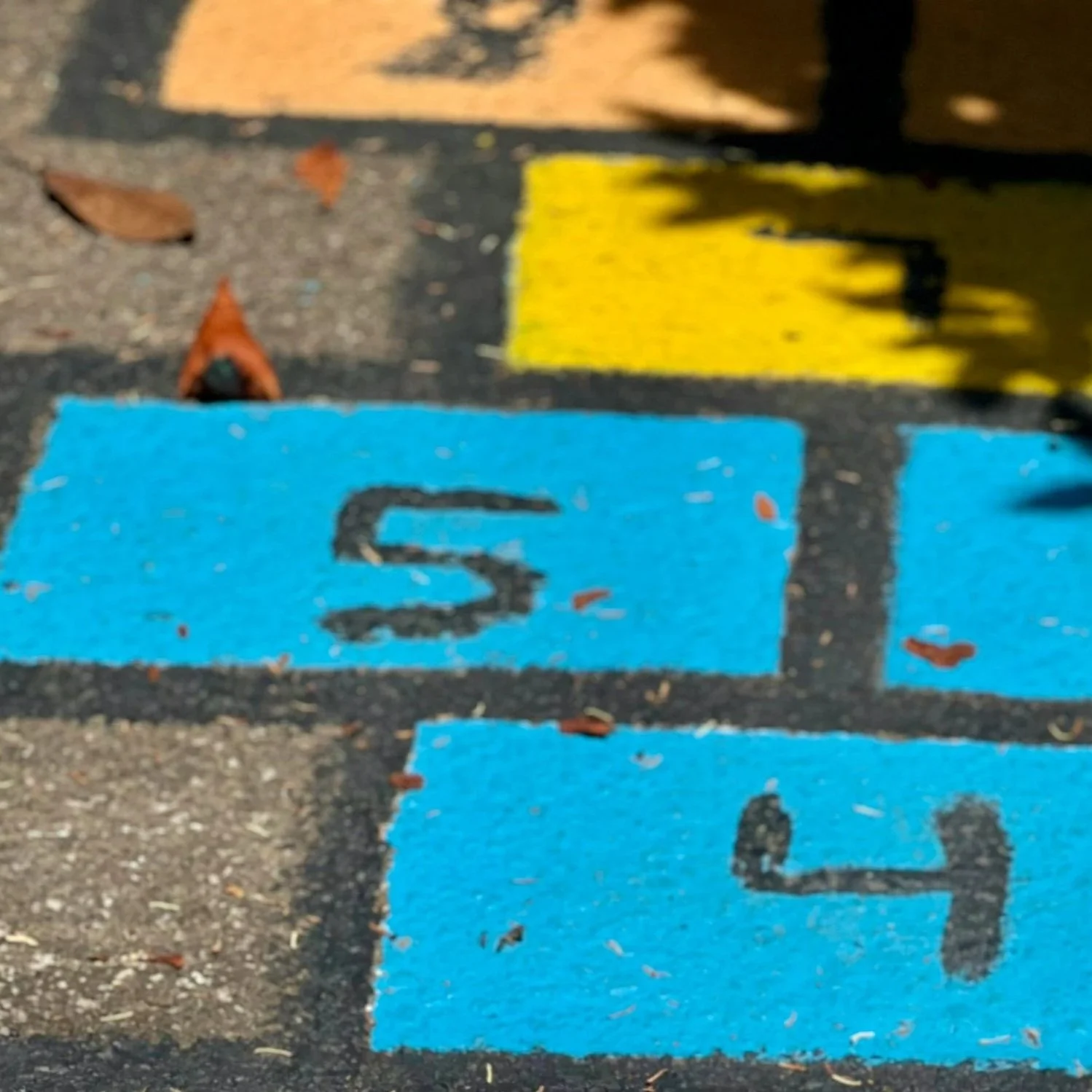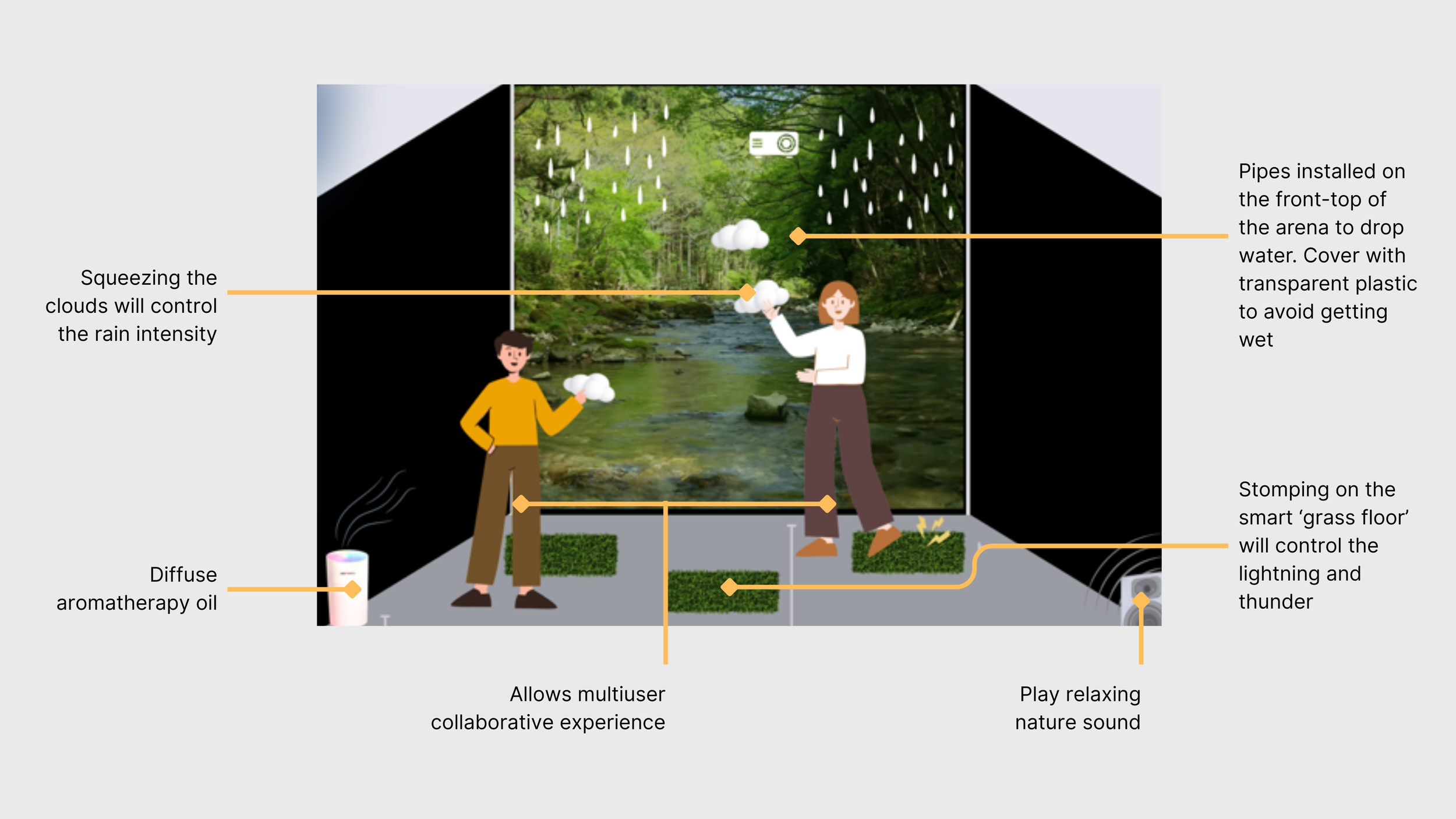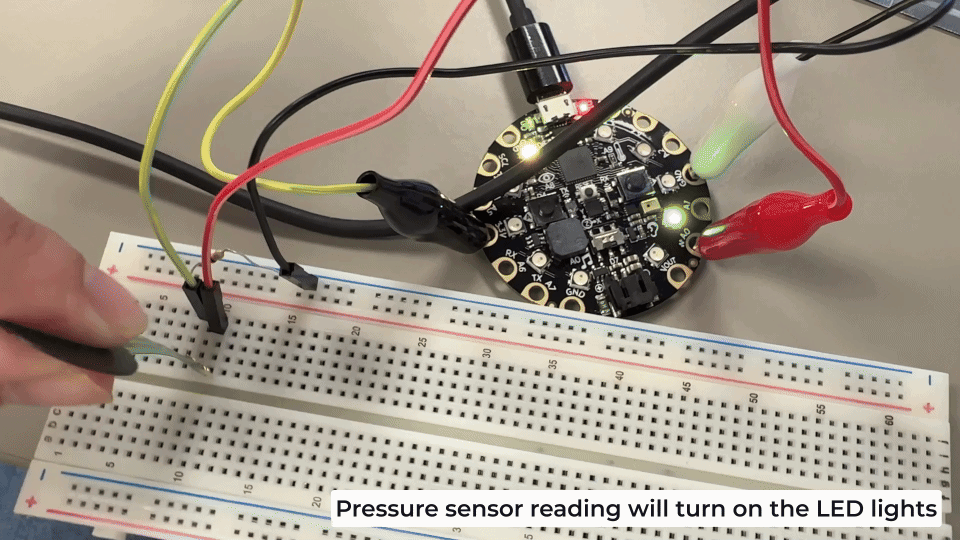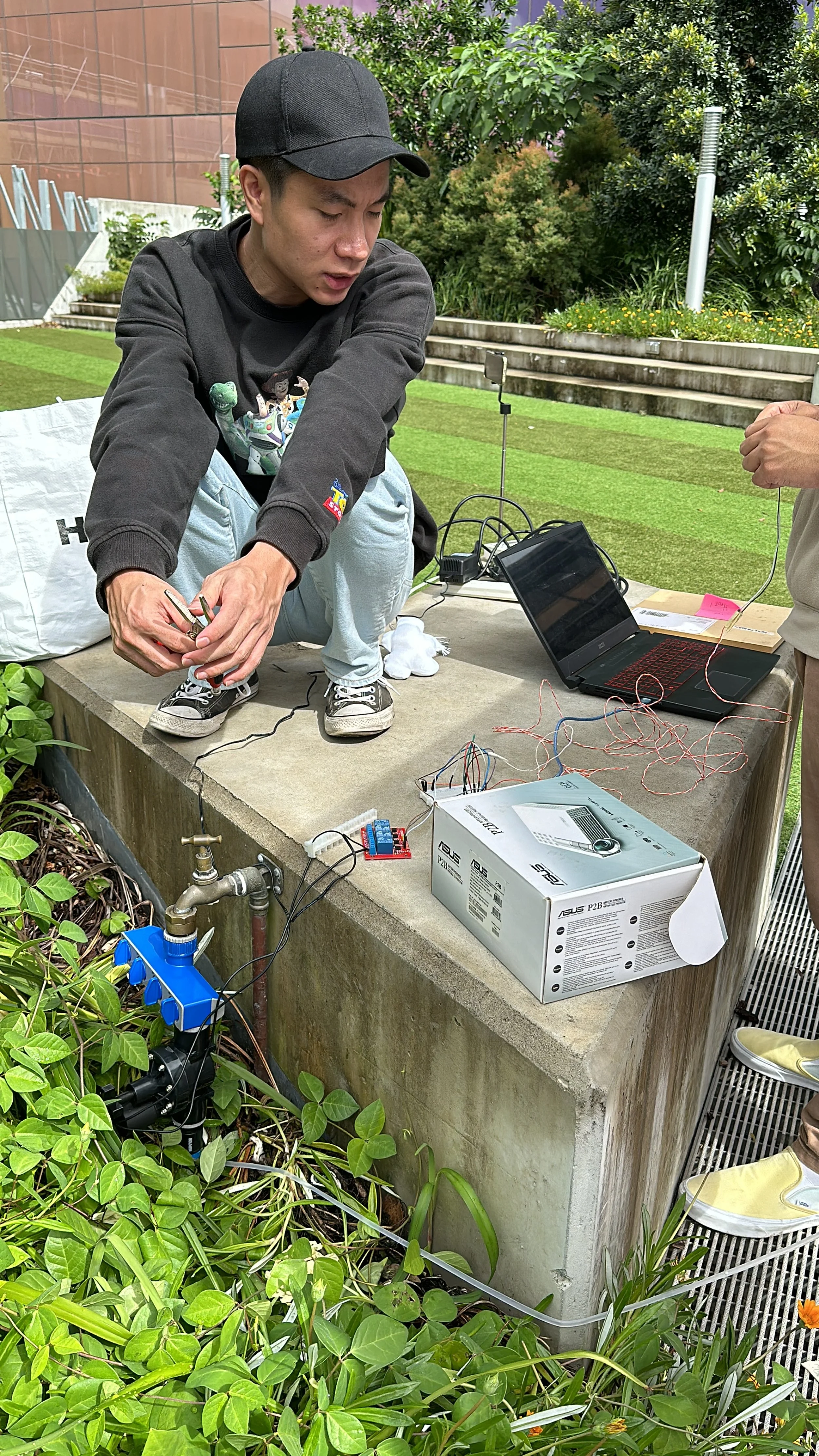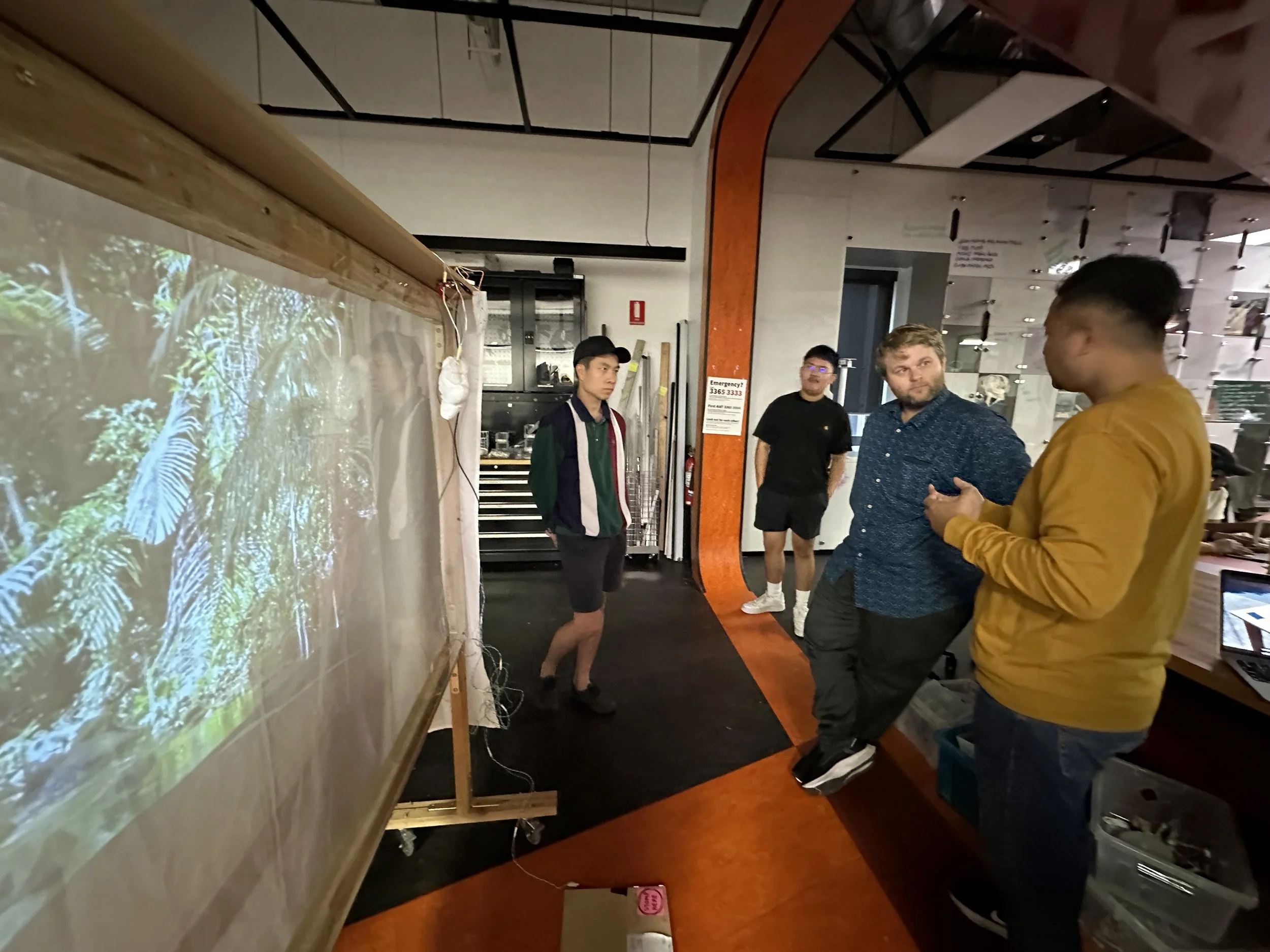Physical Computing Project: Rainscape
A playful, immersive room simulates a rainy natural environment, engaging touch, sight, hearing, and scent, where users interact to reduce stress
Tags: Smart object, interaction design, stress relief, artificial weather control
CONTEXT
Part of the capstone project at The University of Queensland, Australia, under the Physical Computing course
SKILLS & ROLE(S)
Interaction designer, Hardware engineer.
Team of 5 interaction designers
Arduino, Unity, pressure sensors, solenoid valves, fabrics, oil diffuser, speakers
YEAR
2024
TOOLS
WHAT IS PHYSICAL COMPUTING PROJECT?
Physical Computing Studio course is a mandatory course for final year students of Interaction Design programme. Students are exposed to design challenges of building physical interaction design environments.
Through embodied interactions, we are challenged to create physical computing technology—a novel system beyond traditional interactions like touch screen, mouse, or keyboard—that bridges digital and physical components into a prototype.
Physical computing project examples. Images credit to Physical Computing & Interaction Design Studio Course (2024),
School of Computer Science and Electrical Engineering, The University of Queensland, Australia.
THE PROBLEM
Our team chose stress relief as the theme for the project, an objective that most of us seek during our penultimate year of grad school. It was a feeling that we shared with many others that live in big cities.
Studies have found that surrounding oneself with nature can help lower stress levels. Activities such as a brief visit to a park, seeing greenery, or listening to birds chirping or water flowing are especially beneficial for those seeking stress relief. However, limited urban space makes it difficult to create natural green areas within the city. Tall buildings, along with noise from construction and traffic, also make it challenging to fully immerse oneself in nature’s tranquility.
Our project’s goal was to create an indoor space where people can take refuge and relieve their stress by interacting with the smart objects within it.
CHALLENGE
How might we design an interactive space for stress relief that mimics natural environment?

THE PROCESS
This project is using design thinking framework
1 - DISCOVER
Physical Computing Criterias
The project has to accomplish all of the criterias of physical computing that would be marked. It is very clear from the start that we have to avoid all kind of traditional interactions—like using mouse, keyboard, touchscreen—as the modality of the prototype. The challenge here is to create embodied interactions, which is using bodily movement (e.g., gestures) to interact with the technology.
CRITERIA 1
The Future Everyday
How differently will we perform ordinary, mundane, or everyday tasks in the near future?
CRITERIA 4
Physical
Is the interaction involving physical objects? How do we make it tangible/concrete? What movement are we controlling it with?
CRITERIA 2
Playful
Is it provoking human emotions? How do we make it playful/fun/exciting? How do we make it engaging?
CRITERIA 5
Interaction
What is the action-reaction/command-response of the system? What kind of feedback people would get?
CRITERIA 3
Novel
Is it new and original? Is it not like anything we’ve seen before? How do we make it innovative?
CRITERIA 6
Human Values
What are the human values that this system embodies (e.g., thought-provoking, cultural, aesthetics, etc.)
Desktop Research
Aside from anecdotal evidence from friends, family, and ourselves, we did some research on how immersing oneself in nature can help relieving stress.
We conducted brainstorming and feedback sessions from teaching assistants.
KEY FINDINGS
Creating small indoor greenery, like plants or indoor grass, can boost happiness and wellbeing similar to outdoor green spaces [1]
Listening to nature sounds such as birds, rustling leaves, and water not only reduce stress but also mask industrial noise, indicating that a combination of these elements can effectively ease stress [2][3][4]
Inhaling aromatherapy with slow, deep breaths may reduce anxiety by lowering cortisol levels, indicating its potential as a stress management tool [5]
Stress here means negative feelings like feeling overwhelmed, angry, frustrated, worried, or tired.
From there, we thought of:
‘What kind of physical activity or gestures that might relieve these feelings?’
Squeezing stress ball
Known to reduce anxiety levels in patients ondergoing treatments [6]
Stomping on the floor
Playful redirection from anger to calm down in children [7]
Mindfulness meditation
Reduce anxiety and improve emotional regulation [8]
2 - DEFINE
Our idea was to create an enclosed space where visitors can ‘magically transported’ into a serene, natural environment. Here, they can express their emotions through tactile activities and gestures that we described previously, using smart objects. We also added olfactory and audio element to the prototype as a sub-features, making it a multisensory experience.
Visual sketch of our physical computing prototype’s idea
3 - DESIGN
Main Features
INTERACTION 1
Controlling rainfall using cloud-shaped stress ball ☁️
Relieve stress and anxiety by squeezing the cloud. The harder you squeeze, the heavier the rain falls. The sound of rain helps you feel calm.
INTERACTION 2
Controlling lightning by stomping on the grass ⚡️
Redirect your anger energy into playfully stomping on the smart floor. The harder the stomp, the brighter the lightning would be.
System Design
We divided the system into two area:
Interaction artefacts – stress ball, smart floor
Tent installation – water control to the tent
In order to design the system, we proceed through these steps:
What kind of interactions might a user do in the installation?
What are the sensors that we can use to capture the interactions?
What kind of feedback/responses do we give back to the user based on their input?
4 - DELIVER/PROTOTYPE: PROOF OF CONCEPT
First Prototype: Proof of Concept
I prototyped our idea using Arduino Lilypad connected to a pressure sensor to demonstrate the reading for rainfall and lightning:
The user presses sensor → Arduino IDE read values → Output LED: red for high pressure, yellow for medium, and blue for low.
After it worked, I integrated Unity into our system to make readings (based on the values) to create appropriate thunder sound and intensity:
The user presses sensor → Arduino IDE read values → Send reading to Unity → Output LED: red for high pressure, yellow for medium, and blue for low + thunder sound and intensity
Then I worked with my friend who was in charge of the solenoid valves to pass the value reading to his Arduino in order to open and close the water flow. With this, we created two circuits to work on the stress ball (clouds) and the smart floor:
The user stands on the floor → Arduino IDE read values → Send reading to Unity → Output LED: red for high pressure, yellow for medium, and blue for low + thunder sound and intensity
The user squeezes the cloud → Arduino IDE read values → Open solenoid valve → Output water: more pressure = bigger water intensity
INTERACTION 3
Controlling roaring sound of thunder by stomping 🌩️
Feel the environment more by turning your emotions into the sound of thunder. A light tap makes a soft thunder, and a hard stomp makes a loud thunder.
Below is the video demo of the first prototype / proof of concept:
First Iteration Feedback
We tested our prototype on our classmates from different groups and the teaching team. Some feedback and our action plan were as follows:
KEY FINDINGS
“It’s hard to control the rain because the pressure sensors inside the clouds seem unresponsive”
Action plan: make the sensor more tactile, put sensors on a sponge to create more realistic value readings.
“The floor is too sensitive to even the slightest touch, i think it’s supposed to be responsive to the stomping/jumping pressure”
Action plan: readjust the threshold of each pressure level, add a sponge between the sensor and the ground
“Maybe the light step should produce milder thunder sound and hard stomp can create a different yet louder one”
Action plan: create three distinct sounds for each threshold, edit Unity to adjust volume depending on the intensity
“Consider adding 3D effects like aromatherapy and breezy wind?”
“Be careful to not get electrocuted!”
“I like the idea of covering the LED lights with fluffs to make it look like the lightning behind the clouds”
Second Prototype: Improvements
Having our concept proven and approved, we moved on to improve our system design:
Fix issues mention in the feedback
Allow multiple people to collaborate (parallel)
Integrate LED strip to create lightning
My friend and I worked together in coding the LED strip and smart floor connection. Our goal is to create longer and brighter lightning patterns when it detects hard stomps and, likewise, shorter and dimmer when the pressure is low.
To achieve this, we applied physics formulas (see image on the right) to engineered LED lighting systems for Rainscape's thunder and lightning effects, calculating resistor values and current draw to safely interface with Arduino microcontrollers and achieve the desired visual intensity.
4 - DELIVER/PROTOTYPE: FINAL CLOUD STRESS BALL
We created the cloud stress ball by inserting an Arduino-connected pressure sensor into cloud-shaped plushie.
We created the plushies with the fluff from pillow insert and white fabric. The pressure sensor is encased in a dish-sponge to improve the surface area so the reading wouldn’t be too sensitive.
When pressure is detected in the cloud, the data read by Arduino was sent and processed by Unity to give the appropriate feedback to user.
I programmed the Arduino and Unity to collect data from three parallel clouds, creating a shared experience for multiple users to control the space.
After Unity processes the pressure (low, medium, high), it sends a signal to another Arduino that controls solenoid valves to open and close the water flow. This process is behind the ‘magic’ of how user can control the rainfall from squeezing the cloud plushies!
4 - DELIVER/PROTOTYPE: FINAL GRASS FLOOR
As explained in the design stage, we initially would like to create a carpet with piezo sensors stuck underneath for a more seamless appearance. But due to resources and material limitations, we had to compromise using the already available materials in the workshop.
The grass floors are the interaction artefact that controls thunder and lightning.
Also with pressure sensors, we attached them on the back of wooden tiles and covered the top with artificial grass to make it blend with the grass underneath.
The Arduino connects the grass floors with LED strips on the roof, creating the landscape for the lightning.
FINAL PROTOTYPE
5 - USER TESTING
This project was presented in Interaction Design Exhibit Day, where each team has their own stand and guests can come and try. To get feedback of our project, we invited guests to fill in a questionnaire about their experience. We also observe their emotion and comments during the experience.
We were tested by 39 guests, although only few of them fill in the questionnaire.
Questionnaire Results
The questionnaire result from our visitors
Qualitative Results Summaries
POINT 1
Common Keywords Describes Positive Experience
Participants described RainScape using three key themes: (1) tranquillity, (2) positive emotions, and (3) physical objects. This suggests they found RainScape relaxing, emotionally uplifting, and memorable due to its unique multisensory elements.
POINT 2
Greater Appreciation to Nature
When asked about the benefits of RainScape, most participants said it helped them appreciate nature more. One student visitor mentions how the delay between thunder and lightning was just “like we learned it in the classroom”.
POINT 3
Appreciation to Multisensory Approach
Visitors commonly described their experience with rain, thunder, and clouds. One noted that the dark environment, dim lighting, and aromatherapy created a calming atmosphere and asked about the scent choice. These responses show the multisensory approach's effectiveness.
Leadership
I led creation of the base logic for pressure sensors and its coding and circuit implementations on cloud plushies and the grass floors. I also led the unity programs to read values and control the multimedia output, such as the sound produced from the grass floors.
Take aways
Participants feel RainScape's relaxing effect, positive emotions, and lasting multisensory impressions from the novel objects
The feedback validated our hypothesis that Rainscape, our project, can help users feel calm and relaxed because of the multisensory approach to recreates the nature.
We were also influenced by the Art and Science Museum in Singapore where visitors can interact with the environment. But rather than interact with screens, we proved that physical objects can also be an alternative to create an interactive space.
Lessons in Power Management: The Red Lightning Incident
On exhibition day, our warm white LED lightning unexpectedly turned red without any code modifications. Investigation revealed that RGB LEDs require different voltages for each colour channel—when the USB power supply dropped below 4V under sustained load, blue and green channels failed while red (requiring only 2V) continued operating.
This incident highlighted the importance of realistic testing conditions: our 5-10 minute development tests didn't catch issues that emerged during hours of continuous operation.
For future physical computing projects, I will implement dedicated power supplies, sustained load testing, and proper voltage regulation from the design phase rather than as afterthoughts.
References
[1] Reis, S. N., Reis, M. V. D., & Nascimento, Â. M. P. D. (2020). Pandemic, social isolation and the importance of people-plant interaction. Ornamental Horticulture, 26(3), 399-412. https://doi.org/10.1590/2447-536x.v26i3.2185
[2] Tyrväinen, L., Ojala, A., Korpela, K., Lanki, T., Tsunetsugu, Y., & Kagawa, T. (2014). The influence of urban green environments on stress relief measures: A field experiment. Journal of Environmental Psychology, 38, 1-9.
[3] Zhang, J., Yan, H., & Wang, D. (2023). Effects of Acoustic Environment Types on Stress Relief in Urban Parks. International Journal of Environmental Research and Public Health, 20(2), 1082. https://doi.org/10.3390/ijerph20021082
[4] Cai, J., Liu, J., Yu, N., & Liu, B. (2019). Effect of water sound masking on perception of the industrial noise. Applied Acoustics, 150, 307-312. https://doi.org/https://doi.org/10.1016/j.apacoust.2019.02.025
[5] Ozen, N., Berse, S., & Tosun, B. (2023). Effects of using a stress ball on anxiety and depression in patients undergoing hemodialysis: A prospective, balanced, single-blind, crossover study. Hemodialysis international. International Symposium on Home Hemodialysis, 27(4), 411–418. https://doi.org/10.1111/hdi.13102
[6] The Mindful Peach (2024). Dinosaur Stomps and Roars: Channeling Anger Into Playful Movement. https://www.mindfulpeach.co/blogs/news/dinosaur-stomps-and-roars-channeling-anger-into-playful-movement. Online (Accessed Sep 2025).
[7] Goldin, P. R. and Gross, J. J. (2010). Effects of mindfulness-based stress reduction (mbsr) on emotion regulation in social anxiety disorder.. Emotion, 10(1), 83-91. https://doi.org/10.1037/a0018441

